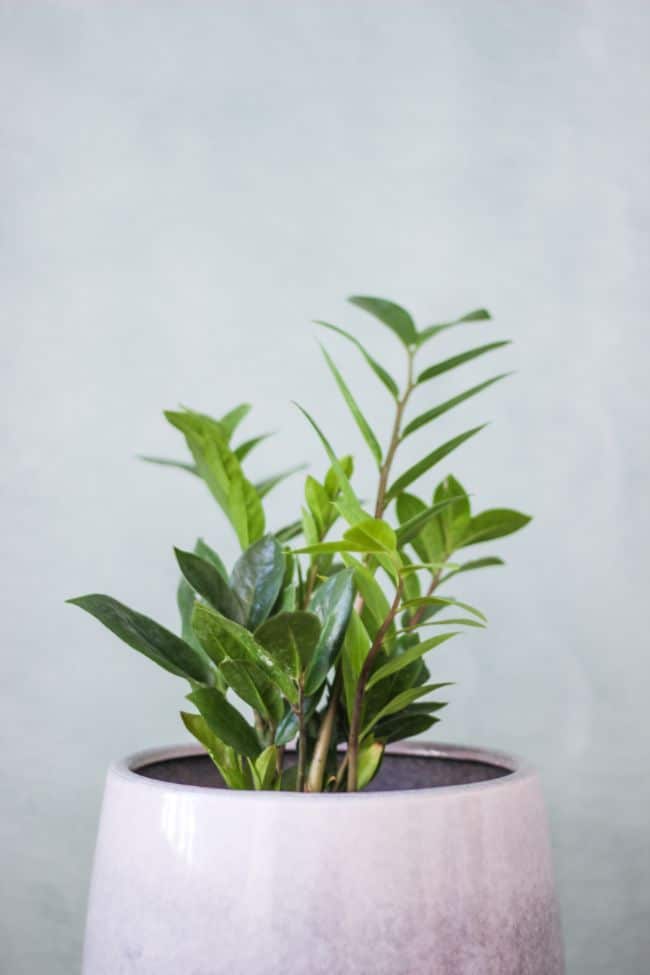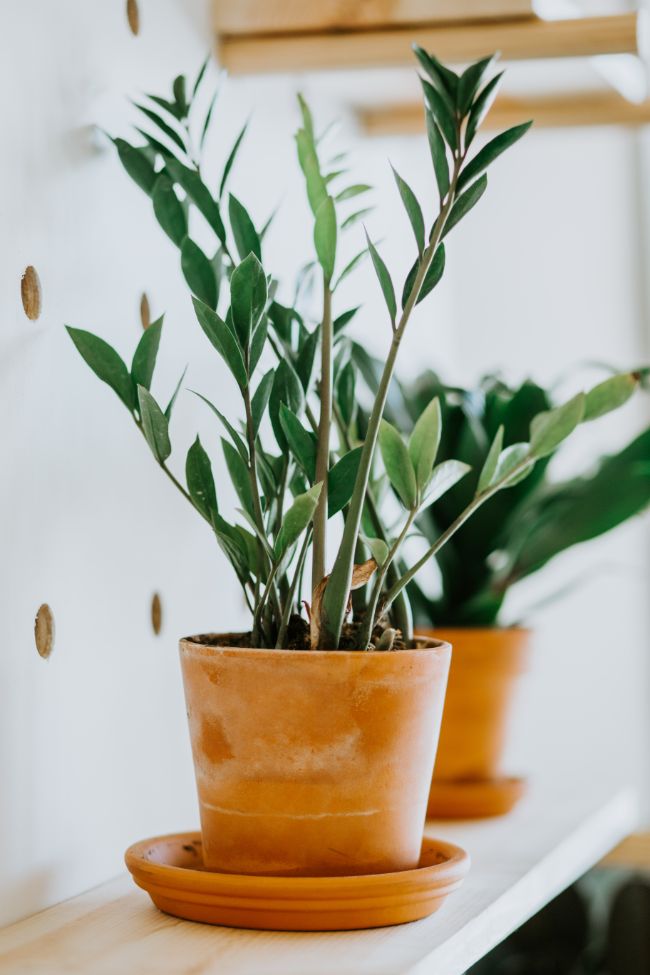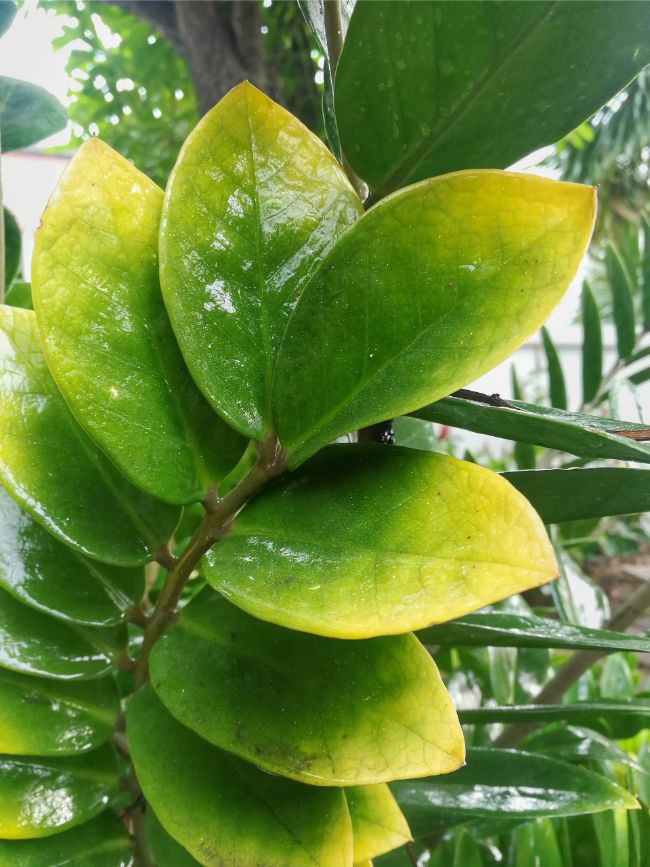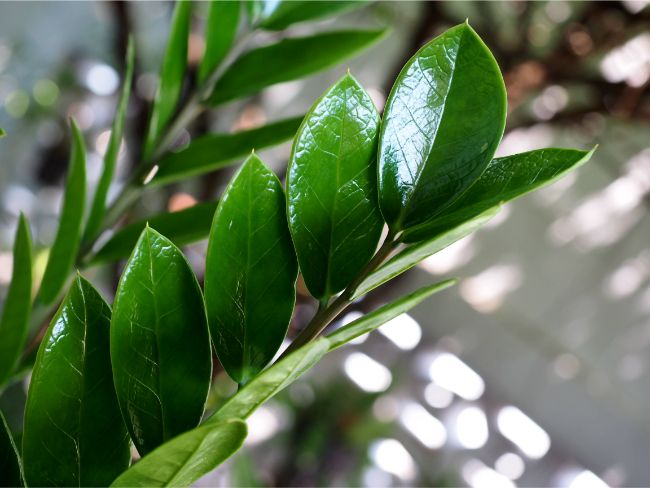The ZZ plant (Zamioculcas zamiifolia) is an excellent choice of low maintenance houseplant that will look fantastic in your home. One of the only things that causes problems is issues with watering. As long as you follow this ZZ plant watering guide, your plant will thrive, even if you occasionally forget about it.
ZZ plant watering instructions: Water your ZZ plant once the potting soil is almost completely dry and then water the plant thoroughly until water drains from the bottom of the pot. Do not water on a schedule, but monitor the individual plant.
ZZ plants are generally very forgiving and low maintenance, but will not tolerate being overwatered. Read on and I’ll explain how to get the watering of this plant right every time.
The Most Important Thing About ZZ Plant Watering
ZZ plants are said to thrive on neglect. They have a tremendous ability to survive with limited light and water, but their achille’s heel is the over-attentive gardener.
We are all keen to nurture our indoor plants, and one mistake that many people make is to give their plants too much water. In the case of the ZZ plant, this can lead to your plant dying from root rot. To make sure you are watering your ZZ plant properly, use the following guidelines.
How To Check If Your ZZ Plant Needs Watered
As already mentioned, it’s important to assess your individual plant before deciding if it needs watered. So many people are told to water their indoor plants on a set schedule, but this only leads to disappointment as it doesn’t take into account the condition of the plant.
Here are some great ways that I use to tell when my ZZ plant needs watered.
- Poke your finger into the potting soil, about 2 inches down. If you feel any moisture, the plant doesn’t need watered.
- Lift the pot up and feel the soil through the bottom drainage holes. If this is dry, or very slightly damp, you can safely water your plant.
- Check the foliage. Drooping leaves with dry, brown edges, or widespread leaf drop indicate a very underwatered plant. Widespread yellowing leaves indicates overwatering.
- Use a chopstick or skewer and poke it into the soil, right to the bottom of the pot. Lift it out and check the stick for dampness. If the end of the stick is wet and has soil stuck to it, the plant doesn’t need watered.
- Check the weight of the pot. Dry soil is lighter than wet soil. Lift the pot every time you check to see if it needs watered. Before long you will have a good idea just by the weight of the pot alone.
- Use a moisture meter. These electronic gadgets are really handy and very cheap. Pop one in the soil for a few minutes and you will get a moisture reading, usually on a scale of 1 to 10. A very handy tool to ensure you only water your ZZ plant when needed.
When you compare your ZZ plant to other houseplants, bear in mind that the ZZ plant has a number of succulent characteristics. The ZZ plant has its own way of storing water in its rhizomes. These bulb-like structures grow above the roots, but below the soil, storing water and slowly releasing it as the plant needs it.

Amount Of Water Used
If ZZ plants hate being overwatered, should you only water them a little at a time?
The short answer is no. Every time you water your ZZ plant, you should do so thoroughly. It is good to saturate the entirety of the potting mix as this allows excess mineral salts to be washed through the potting mix, rather than building up, and ensures that the roots get adequate access to moisture at each watering.
I actually take my indoor plants to my kitchen sink to water them. I add enough water to the top of the pot so that water flowly freely from the drainage holes at the bottom.
An interesting thing about many potting soils is that they behave like sponges. Have you ever noticed that a dry sponge sometimes seems to repel water until it gets really wet? Soil can be much the same. For this reason, I usually add a bit of water first and let the soil start to absorb it for a few seconds. I then add a bit more and take another break. Once I feel the soil is really starting to absorb the water, I water freely, ensuring that the potting mix is saturated.
I let the pot sit in my sink for a few minutes until no more water drains from the drainage hole, before taking it back to whereever I have it on display.
For those concerned about this technique leading to problems with overwatering, I have a solution. Choose a porous pot, well draining potting soil and a pot that is not excessively large. This will ensure that the soil dries out in a reasonable timeframe.
Factors Affecting ZZ Plant Watering
So now you know how to assess whether your ZZ plant needs watered, and the process for doing it, it is really important to know a bit more about the factors that can influence how often you will need to water your ZZ plant.

1. Climate
One important factor that will determine how much and how often you water your ZZ plant is the climate that you are growing the plant in.
If you live in a warm, dry climate then water will evaporate from the soil more quickly, the plant will lose more water from the leaves, and the plant will also grow more quickly, which will increase the amount of water that it needs.
Whilst you should always be assessing the plant andn the dryness of the potting material to determine when to water your ZZ plant, your climate will determine how often you need to check your plant.
I often find that during the winter, when my ZZ plant is not actively growing, and indoor temperatures are cooler, with less ventilation, that I often only have to water my ZZ plant once every 4 weeks. This can increase to weekly watering during the hotter summer months when my plant is thriving.
2. Potting Medium
The type of potting medium you use to grow your ZZ plant will have a dramatic impact on how often you need to water your plant and how quickly the potting medium dries out.
It is important to use a well draining potting mix so that excess water drains away from the roots quickly after you water your ZZ plant. I use a mix of potting compost and perlite, as this provides plenty of drainage and aeration, while allowing a little water retention.
When you water your ZZ plant, the sign of a well draining potting medium is that the water drains quickly through the pot and starts draining out of the drainage holes, rather than sitting in a puddle on top of the potting medium for more than a few seconds.
If you notice slow drainage, repot your ZZ plant with potting mix with added perlite or coarse sand.
3. The Type Of Pot Is Important For ZZ Plant Watering Success
Porous pots allow the free transfer of water and oxygen through the walls of the pot. Unglazed clay pots are ideal for ZZ plants as they significantly reduce the risk of overwatering.
Plastic or glazed ceramic pots will hold water in the potting material until it is either used by the plant, drains from the bottom drainage holes, or evaporates.
That brings up another point. Always ensure that whatever pot you use has drainage holes. This is essential! It’s really really difficult to deliver exactly the right amount of water into a pot with no drainage holes each time. Excess water will pool at the bottom of the pot and is is almost inevitable that you will end up with root rot.
Large drainage holes allow any excess water to drain out rapidly, improving root aeration and greatly reducing the risk of root rot. Also, if you put your pots on a drip tray or inside an outer decorative pot, don’t forget to drain the excess water 5-10 minutes after you water your ZZ plant.
I put almost all of my indoor plants into outer decorative pots. This means I can pick the perfect pot to suit the plant on the inside, but still get to pick fantastic looking pots on the outside that fit with my home decor. Check out some of my favorite decorative pots in this article.
What To Do If You Have Overwatered Your ZZ PLant

If you notice your ZZ plant leaves are turning yellow, the stems are drooping the plant is looking a little unhappy, the first suspect is overwatering.
Check the potting soil to see if it is saturated. If so, you have probably got a case of root rot and your plant is very sick indeed. You will need to repot your plant immediately if you want to have a chance of saving it.
Remove your ZZ plant from it’s pot and gently separate the potting soil from around the roots. Rotten roots will be fragile, mushy and black/brown in color. You will need to remove all affected roots with a pair of clean pruners or scissors. If there are not sufficient healthy roots remaining, your plant is unlikely to survive.
Assuming there are still some healthy roots remaining, you should repot your ZZ plant in very well aerated potting mix, in a porous pot with plenty of drainage holes. Root rot is caused by a fungal infection that thrives in waterlogged soil. For this reason, I would strongly advise using a different pot from previously.
ZZ Plant Watering Summary
Avoid overwatering your ZZ plant, and you will enjoy this beautiful indoor plant for years to come. Follow the advice in this article and you should have no problems at all. Just remember to check your plant regularly and forget about watering on a schedule.
Now that you know how to water your ZZ plant to perfection, you should check out some related articles I have written.

